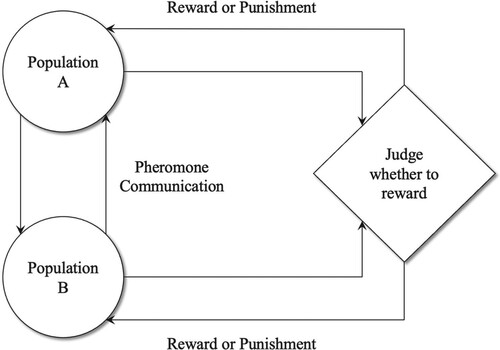 ?Mathematical formulae have been encoded as MathML and are displayed in this HTML version using MathJax in order to improve their display. Uncheck the box to turn MathJax off. This feature requires Javascript. Click on a formula to zoom.
?Mathematical formulae have been encoded as MathML and are displayed in this HTML version using MathJax in order to improve their display. Uncheck the box to turn MathJax off. This feature requires Javascript. Click on a formula to zoom.Abstract
Based on AI technology, this study proposes a novel large-scale emergency medical supplies scheduling (EMSS) algorithm to address the issues of low turnover efficiency of medical supplies and unbalanced supply and demand point scheduling in public health emergencies. We construct a fairness index using an improved Gini coefficient by considering the demand for emergency medical supplies (EMS), actual distribution, and the degree of emergency at disaster sites. We developed a bi-objective optimisation model with a minimum Gini index and scheduling time. We employ a heterogeneous ant colony algorithm to solve the Pareto boundary based on reinforcement learning. A reinforcement learning mechanism is introduced to update and exchange pheromones among populations, with reward factors set to adjust pheromones and improve algorithm convergence speed. The effectiveness of the algorithm for a large EMSS problem is verified by comparing its comprehensive performance against a super-large capacity evaluation index. Results demonstrate the algorithm's effectiveness in reducing convergence time and facilitating escape from local optima in EMSS problems. The algorithm addresses the issue of demand differences at each disaster point affecting fair distribution. This study optimises early-stage EMSS schemes for public health events to minimise losses and casualties while mitigating emotional distress among disaster victims.
1. Introduction
Public health emergencies inflict severe damage on public health and result in significant economic losses (Sodhi, Tang, and Willenson Citation2023). Emergency medical supplies scheduling (EMSS) plays a pivotal and decisive role in the effective management of disasters (Chen, Guo, and Tsui Citation2020; Shirazi, Kia, and Ghasemi Citation2021; Zhan et al. Citation2021). Artificial intelligence (AI) offers a novel technical solution for addressing public health emergencies (He et al. Citation2022; Li et al. Citation2021; Vishwakarma et al. Citation2023). Medical supply scheduling poses a significant challenge during public health emergencies. Effective allocation of medical resources is crucial in ensuring patient recovery and preventing the spread of pandemics (Boutilier and Chan Citation2020; Gökalp, Cakir, and Kougkoulos Citation2022). With the outbreak of the COVID-19 pandemic in early 2020, the emergency response of public health emergencies has become the focus of global attention (den Berg and van Essen Citation2019; Ding et al. Citation2019; Lu, Ying, and Chen Citation2016; Mills, Argon, and Ziya Citation2018), and the EMSS is particularly critical (Wang, Cui, and Fang Citation2023). Utilising AI in addressing the supply scheduling problem has emerged as a prominent area of research, with a particular emphasis on resolving the challenge of identifying the globally optimal solution (Chang et al. Citation2023a; Shrivastav Citation2022; Yi et al. Citation2022; Zhou et al. Citation2023).
After Wuhan announced the city's closure, people's livelihood and protective equipment relied on the government and various platforms for dispatch and distribution. How to send scarce emergency medical supplies (EMS) to the most needed places to meet the emergency needs of hospitals and citizens became the primary concern (Boutilier and Chan Citation2020; Ekici, Keskinocak, and Swann Citation2014; Jenkins, Robbins, and Lunday Citation2021). Emergency logistics differ from general commercial logistics, for it is a specialised activity aimed at maximising time benefits and minimising disaster losses caused by sudden and unpredictable factors (Wang, Yang, and Yang Citation2023; Wilson et al. Citation2016). The objective of EMSS is to accomplish prompt and efficient rescue with less emphasis on the impact of cost (Cerna et al. Citation2021). However, most of the disaster losses caused by the new outbreak are caused by the lack of timely and reasonable EMSS. Emergencies can lead to sudden changes in demand, insufficient stocks of medical supplies, limited transportation capacity, and shortages of raw materials (Adulyasak, Cordeau, and Jans Citation2014; van Lieshout, Bouman, and Huisman Citation2020). In order to strengthen emergency logistics management, it is necessary to optimise the rescue effect by constructing a rescue decision-making model and algorithm to help decision-makers make reasonable plans (Fukasawa et al. Citation2018; Nasrollahzadeh, Khademi, and Mayorga Citation2018). AI provides information for predictive analysis that supports complex decision-making processes (Yüksel et al. Citation2023).
The optimisation objective of EMSS can generally fall into the following considerations: fairness of distribution, timeliness of rescue, and economy of scheduling. As the social and economic losses in the pandemic far exceed the cost of EMSS, the impact of scheduling costs should not be emphasised. At the early stage of the pandemic, disaster relief medical supplies cannot meet the needs of all the impacted areas; the fairness of medical supplies distribution is related to the development of the disaster situation. With a focus on fairness and timeliness, we propose an algorithm to solve the multi-objective EMSS problem, where fairness is evaluated through the improved Gini coefficient, and timeliness is assessed by scheduling time. Given the varying demand for EMS in different disaster areas, this study employs the medical supply satisfaction rate to calculate the Gini index when measuring the distribution fairness of EMS (Alem, Caunhye, and Moreno Citation2022). The Gini coefficient is a relative index, which conforms to the principle of scale invariability and transfer, and can generally reflect the different degrees of the overall distribution. The algorithm solves the problem that the demand difference of each disaster point affects the fair distribution. The study optimises the EMSS scheme in the early stage of public health events, which can reduce the loss and casualties and appease the emotion of disaster victims. Heterogeneous ant colony algorithm (ACS-MMAS) that combines the ant colony algorithm (ACS) and max and min ant algorithm (MMAS) is used to solve the local optimal problem (Li, You, and Liu Citation2021). Our key finding is to show that the ACS-MMAS based on reinforcement learning mechanism is superior to ACS and MMAS in convergence speed and search efficiency and can effectively jump out of local optimum. With the increased iteration times, the HV index of ACS-MMAS has obvious advantages compared with ACS, MMAS, and NSGA-II.
The research objective of this paper is to address the optimal dispatching problem of emergency supplies. Previous vehicle path planning problems have been considered only under constrained conditions. Given the unpredictability and suddenness of emergencies, it becomes challenging to anticipate them in advance, thereby emphasising the significance of efficient emergency material dispatching. Consequently, this paper aims to investigate the following research questions:
RQ1: How can AI technology be utilized to plan the delivery vehicle route to achieve the intended goal, considering the increased complexity of medical supply scheduling, including distribution and transportation planning?
RQ2: How can AI technology be utilized to equitably allocate emergency medical resources, in conjunction with collaborative research on the distribution and routing of medical supplies, to design effective allocation strategies that minimize disaster losses?
The rest of the paper proceeds as follows. Section 2 reviews prior literature on EMSS problems in emergencies. Section 3 presents our model definition and formulation. Section 4 demonstrates the proposed design of the algorithm. Section 5 shows the experimental simulation and analysis. The last section concludes the paper.
2. Literature review
EMSS can be viewed as an extension of the vehicle routing problem (VRP) in the context of emergency management. Some studies have focused on achieving a single completion of EMSS following an emergency event (Ying et al. Citation2023), but the demand for medical supplies is continuous for medical consumables. Lu, Ying, and Chen (Citation2016) proposed a disaster relief supplies distribution framework based on the dynamic framework of the disaster level. The allocation of EMS resources must adhere to the principles of equity and justice while also considering the urgency of rescue operations (Liu et al. Citation2022).
In the early stage of an emergency, the rapid response ability and rescue effect of the emergency system mainly depends on the length of rescue time. Some studies consider the single objective optimisation of the shortest rescue time. For instance, Wan, Ye, and Peng (Citation2023) proposed a two-pole EMS model for multi-commodity and multi-vehicle transportation, which minimises the time cost by integrating a genetic algorithm and analytic hierarchy process. Chang et al. (Citation2023b) studied the multi-rescue point EMS model under a real-time dynamic road and realised dynamic vehicle path adjustment through an improved genetic algorithm to solve the shortest time.
Some scholars consider the shortest distance in the rescue process to improve rescue efficiency by the principle of proximity. For instance, Deng et al. (Citation2023) examined the EMS model of a single distribution centre and multiple disaster points and proposed a concept of two-way distribution to improve the transportation efficiency of EMSS. In the early stage of the disaster, the government and the people not only care about the distribution efficiency of medical supplies but also pay attention to the fairness of rescue. Therefore, there are studies on the scheduling of EMS from a fairness perspective. For instance, Wang, Zhao, and Wu (Citation2023) investigated a distance-based service priority strategy, which will reduce service wait times for customers farther away by giving higher service priority.
Since EMSS is a nondeterministic polynomial (NP) problem, most studies only focus on unilateral optimisation (Rautenstrauss, Martin, and Minner Citation2023). However, given the massive impact of emergencies, there is more than one objective to be optimised. Some studies have devoted themselves to using multi-objective optimisation technology to solve this problem. For instance, Kuo, Leung, and Yan (Citation2023) explored three optimisation objectives: minimising driving distance, reducing delay time, and optimising vehicle utilisation. Lopes et al. (Citation2022) combined Ant Colony Optimisation (ACO) and genetic algorithm (GA) to form a hybrid heuristic algorithm to solve a single-objective and multi-objective travelling salesman problem. Fernández Gil et al. (Citation2023) studied the Cumulative Vehicle routing problem with time Windows (CumVRP-TW) as a variant of the vehicle routing problem that minimises the cumulative cost function while respecting customer time window constraints. Combining a saving algorithm and a 2-opt algorithm, Gao et al. (Citation2021) developed an emergency transportation plan to achieve fairness and effectiveness. The emergency materials dispatching is summarised below, as shown in Table .
Table 1. Emergency supplies dispatch table.
Due to the limited EMS stored in the city during public health emergencies, medical supplies need to be quickly dispatched to disaster-stricken areas. The existing emergency material scheduling supply chain structure is generally a three-level supply chain network only suitable for regional material scheduling (Wang et al. Citation2022). To deal with the excessive data requirements and high computational complexity in the new pandemic, the ‘Distribution Center-Disaster Point’ mode is more suitable for large-scale EMSS, which can quickly form the emergency supply chain network among cities and respond to the unified dispatching of the government. With the continuous development of AI, big data, and other technologies, new technical support has been proposed for supply chain management (Alshurideh et al. Citation2022; Hasan et al. Citation2022). The supply chain covers the entire production and distribution channel from suppliers, manufacturers, and distributors to end customers (Helo and Hao Citation2022). Existing research has been conducted on supply network outages to analyse their causes and improve network resilience from different AI perspectives and techniques (Liu et al. Citation2016; Toorajipour et al. Citation2021). Therefore, it is crucial to study the optimisation of medical supplies distribution in the supply chain by using manpower.
The application of AI in medical supplies optimisation scheduling has achieved remarkable results (Kumar and Dimitrakopoulos Citation2021; Noriega and Pourrahimian Citation2022; Yang et al. Citation2021). Using AI in multi-objective optimisation of medical supplies scheduling has become possible (Petrović et al. Citation2022). Reinforcement learning has a good application to resource scheduling optimisation problems. The scheduling problem can be expressed as a reinforcement learning problem, and the optimal solution is found by the simulation of the reward function (Hu et al. Citation2020; Lin, Chen, and Hsieh Citation2023). AI technology in medical (Yang et al. Citation2021) and intelligent factories (Hu et al. Citation2020; Lin, Chen, and Hsieh Citation2023) have made excellent progress in scheduling optimisation. Overall, on the positive side, it is agreed that the use of AI and robots in logistics and production systems can speed up operations and reduce errors (such as those caused by humans), and the use of AI will also significantly improve decision-making (Dolgui and Ivanov Citation2022). Against this backdrop, our paper will strengthen the learning and application to solve the problem of EMSS and improve the rationality and time of medical supplies scheduling.
Based on a comparison of existing literature on emergency management, we propose the ACS-MMAS approach to address the challenge of multi-objective EMSS. ACS-MMAS refers to the ACS-MMAS proposed in this study, which is a mixture of two adaptive ACS and MMAS. Fairness is measured by the improved Gini coefficient, and timeliness is measured by the scheduling time. ACS is responsible for the convergence speed of the algorithm. MMAS, an adaptive ant colony algorithm, is responsible for the diversity of the algorithm. The reinforcement learning mechanism (Zhou et al. Citation2022) has been introduced to update pheromone exchange among populations. The experimental results show that the algorithm can effectively reduce the convergence time, help jump out of local optimum in EMSS problems, and perform better than other heuristic algorithms.
3. Model
3.1. Problem definition
After the occurrence of public health emergencies, the EMS stored in the city is limited, so it is necessary to schedule medical supplies for disaster-stricken areas. The distribution of the affected areas is irregular. According to the territorial principle, medical supplies distribution centres are set up in areas with less impact of the epidemic to ensure the safety of medical supplies. The local management department selects logistics enterprises to provide medical supplies distribution services. To clarify the scope of this paper, we put forward the specific assumptions of the model as follows.
Assumption (1) In the scheduling process of emergency materials, the emergency materials are stored in the distribution centre after arriving in the affected area and then transported to each demand point by the distribution centre. The capacity of the distribution centre is large enough not to consider the situation of a warehouse explosion.
Assumption (2) Each vehicle’s fuel efficiency, driving velocity, and load capacity shall remain constant and uniform, while the volume of goods transported must not exceed the maximum carrying limit.
Assumption (3) Despite the priority division of demand points, all demand points must be allocated a certain amount of emergency materials to meet basic living needs.
Assumption (4) Road transportation is only considered from the distribution centre to the demand point. Vehicles depart from the distribution centre and return to the original distribution centre after completing the transportation task. The same vehicle only serves the same demand point once, and the same demand point can be served by different vehicles, and the distribution centre has enough vehicles to complete the distribution task.
Assumption (5) The road surface between each distribution centre and the demand point is smooth, and the epidemic does not affect highway traffic. In distribution, unexpected situations such as vehicle failure and road congestion are not considered. All transport vehicles have the same speed, and the maximum carrying capacity of vehicles of the same type is the same.
Assumption (6) There are many types of emergency materials. According to the experience of previous public health events, different types of emergency materials are combined into similar materials in proportion to maximise the distribution efficiency, so this paper only considers the distribution of single materials.
The decision variables of the model are and
, which are defined as follows:
(1)
(1)
(2)
(2)
The parameters list and their definitions are summarised in Table .
Table 2. The parameter list.
3.2. Priority evaluation index of EMS
The priority of the demand point is affected by many factors, and different factors have different effects on the rescue priority of the demand point. According to the characteristics of the disaster information of the demand point, the influencing factors can be divided into qualitative and quantitative factors, and the determinate factors mainly include the disaster degree of the demand point, the disaster grade evaluated by the relevant departments, and the time urgency of the demand point. The quantitative factors mainly include the population density of the demand point, the shortage of supplies at the demand point, and the number of patients at the demand point. Therefore, when constructing the priority index of the demand point, the influence of each factor on the priority should be comprehensively considered. Referring to the existing research findings, we determine the priority of the demand point of EMS in public health events by two parts.
Level of expected time demand
The time tolerance of the requirement
3.3. Model of equitable distribution of emergency supplies
3.3.1. Fair allocation model based on priority index
Some scholars have studied the EMSS problem from different angles. The optimisation objective can be divided into one of the following categories by considering: (i) the fairness of distribution to maximise the cumulative satisfaction rate of disaster points (Luo, Wan, and Wang Citation2022); (ii) the timeliness of rescue to minimise the scheduling time (Liu et al. Citation2022); and (iii) the economy of schedule to take the minimal scheduling cost as the goal (Kundu, Sheu, and Kuo Citation2022).
According to the experience of the new pandemic, the social and economic losses caused by public health events far exceed the cost of EMSS, so our model does not consider the impact of dispatch costs beyond the number of vehicles. At the beginning of the emergency, the medical supplies and rescue materials stored in the city can not meet the needs of all disaster areas, and the fairness of the distribution of medical supplies is related to the panic psychology of the masses and the development of the disaster situation. In this paper, the Gini coefficient (Gini) is introduced, which is a relative index that conforms to the principle of scale invariability and transfer, and can generally reflect the different degrees of the overall distribution (Gini Citation1912; Gini Citation1921). As the demand for EMS in disaster areas varies greatly, the Gini coefficient of the satisfaction rate of medical supplies is used to calculate the fairness index of EMS when measuring the fairness of EMS distribution (Zhang et al. Citation2023). In this paper, a distributive equity index G based on the Gini coefficient is constructed, and the calculation is shown in Formulas (5) and (6).
(5)
(5)
(6)
(6) where
is the emergency degree of a medical supplies demand for the disaster site i,
is the satisfaction rate of each disaster point, and
is the average level of satisfaction rate of each disaster point. When the priority of a demand point
(
) is larger, the material distribution is more inclined to it to some extent. In summary,
is constrained to construct the fair distribution model of materials, as shown in Formula 7,
(7)
(7)
(8)
(8)
(9)
(9)
(10)
(10)
(11)
(11)
Formula (7) is the fairness objective function, which reflects the fairness of material distribution by minimising the fairness index. The smaller the value, the smaller the difference in demand point satisfaction rate and the better the fairness. Formula (8) represents the average satisfaction rate of all demand points in the distribution network, and Formula (9) indicates that the actual distribution quantity obtained by each demand point does not exceed its actual demand. Formula (10) denotes that the priority index of each demand point is greater than zero, and Formula (11) symbolises that each demand point is guaranteed to have emergency material distribution.
3.3.2. Emergency vehicle routing optimisation model
According to the problem description, the mathematical model is established as follows. The emergency distribution network has m distribution centres as transit points to distribute relief materials to each demand point, and each distribution centre has enough vehicles to complete the distribution task. There are n demand points, and the distribution task is carried out according to the material distribution scheme in the previous section. From the start of the distribution centre to the completion of the entire distribution network, the vehicle delivery time mainly includes two parts: the travel time and the service time of vehicles arriving at the demand point in the process of vehicle distribution. According to Assumption (5), the waiting time of vehicles in the process of distribution is not considered. For the efficiency cost problem of vehicle routing optimisation, the minimum penalty cost in the process of distribution is taken as the objective, and a dual-objective optimisation model is established as follows:
(12)
(12)
(13)
(13)
(14)
(14)
(15)
(15)
(16)
(16)
(17)
(17)
(18)
(18)
(19)
(19)
(20)
(20)
(21)
(21)
Formula (12) represents the minimum scheduling time. Formula (13) denotes the minimum penalty cost. Formula (14) indicates that the distribution volume of the distribution centre does not exceed the total distribution volume of the allocated demand point. Formula (15) specifies that the total distribution volume of a vehicle does not exceed the maximum carrying capacity. Formula (16) characterises that the scheduling process is continuous, and the path is not repeated. Formula (17) symbolises the subcircuit elimination constraint, and Formula (18) means that a demand point is served by at least one vehicle. Formula (19) shows that there are no vehicles between any two distribution centres. Formulas (20) and (21) suggest that the vehicle returns to the original distribution centre after completing the transportation task.
4. Algorithm design
Next, we analyse the research methods in detail from the perspective of AI, compare the advantages and disadvantages of other models and the ant colony algorithm based on reinforcement learning proposed in this paper, and introduce the basic principle of implementing the ant colony algorithm based on reinforcement learning.
4.1. ε-constraint method
There are four kinds of solving methods for multi-objective optimisation problems: (1) evaluation function method, which transforms multi-objective into a single objective by constructing an evaluation index (Petchrompo et al. Citation2022); (2) interactive programming method, in which decision-makers analyse the prior information in the process of optimisation and gradually generate the final solution (Tomczyk and Kadziński Citation2022); (3) layered solution, which is sorted according to the importance of the objective function, and then solves the single-objective optimisation problem (Deng et al. Citation2022); and (4) generation method (Tian et al. Citation2021). Decision-makers can find a satisfactory solution for solving the Pareto solution set of multi-objective functions according to the actual situation. In the bi-objective optimisation problem, the ε constraint method has a wide range of functions. Similar to the hierarchical sequence method, the optimal solution of the pre-order objective is obtained first, and then the optimal solution of the former objective is transformed into the constraint condition of the latter one. The fairness of emergency dispatch is more important in the early stage of an emergency. Firstly, the optimal value of the Gini coefficient is solved to determine the lower bound , supposing the Gini coefficient of initial distribution be the upper bound
. For the objective function
increasing from the lower bound to the upper bound, a set of optimal solutions of (
can be calculated for each value of ε. Let ε =
, such that ε decreases continuously from the upper bound
to the lower bound
. According to the Pareto-dominated method, the non-dominated solution is the Pareto fronts of the original problem. The bi-objective model is transformed as follows:
(22)
(22)
(23)
(23)
(24)
(24)
(25)
(25)
(26)
(26)
(27)
(27)
(28)
(28)
(29)
(29)
(30)
(30)
(31)
(31)
(32)
(32) where
takes all the values of the objective function
. Firstly, in the range of
restricted domain, Formula (23) is taken as the constraint condition of the objective function
, and the optimal solution of the objective function
is solved to obtain a set of Pareto optimal solutions. Then
is reduced from the upper bound to the lower bound, and each
value has a corresponding optimal solution
, and so on to obtain many groups of Pareto solutions. Finally, the Pareto solution set and Pareto frontier are obtained.
The process of the algorithm is as follows.
Step 1: Initialisation parameters, according to the proportion of demand to determine the initial value of the distribution , and calculate the initial Gini coefficient
. As the upper bound
, let
, and current iterations iter = 1.
Step 2: Calculate the satisfaction rate of each disaster site . Find out the maximum disaster point
and the minimum disaster point
. Adjust the ζ% of the distribution volume of the disaster-hit point with the maximum satisfaction rate to the disaster point with the minimum satisfaction rate; ζ is a constant and meets the condition of
. Otherwise, adjust to the disaster point with the secondary low satisfaction rate.
Step 3: If , return to step 2; otherwise, the algorithm ends. When the Gini coefficient is the minimum, output the optimal solution of distribution quantity
and Minimum Gini coefficient as the lower bound of the objective function
.
Step 4: Let , calculate the minimum path
of the single objective function
under this constraint, and substitute
into the objective function
to determine whether it is a Pareto solution.
Step 5: Determine the step size of upper and lower bounds . If
, return to Step 2; otherwise, end the algorithm, output Pareto solution (
.
4.2. ACS algorithm
4.2.1. Path choice
The ant colony system was proposed by Dorigo and Gambardella (Citation1997). Based on the ant colony algorithm, three improvements have been made: (1) state transition with pseudo-random probability; (2) updating pheromone only on the optimal ant path; (3) adding local update rules to adjust the amount of information in each path. State transition rules of ants moving from i to j in ACS:
(33)
(33) where S stands for the ant to choose the next point to go, and q is a random number evenly distributed on [0,1].
is a certain value, and the parameter Q can be changed
to adjust the ant's ability to explore new paths. s represents a roulette choice, and the formula is as follows:
(34)
(34) in which
is the pheromone concentration between points i and j after t iterations,
is the reciprocal of the distance between points i and j, α and β are the information heuristic factor and the expected heuristic factor respectively, and ‘allowed’ is the current ant feasible point set.
4.2.2. Pheromone update
In the ACS algorithm, when all ants complete a path exploration, only the optimal ant is selected to release a pheromone, which speeds up the convergence speed and reduces the complexity of the algorithm. In the global update of pheromone, ACS update rules are as follows :
(35)
(35)
(36)
(36) where
(0 ≤
≤ 1) is the Volatilisation Coefficient of global pheromone, pheromone increment
is the reciprocal of
, and
is the current optimal path length. After the ant cycle, ACS updates the pheromone of each ant's path to narrow the gap between the pheromone and the optimal path pheromone. In the local updating of pheromone, ACS update rules are as follows:
(37)
(37) in which
is the initial pheromone concentration on each path.
4.3. MMAS algorithm
MMAS algorithm was proposed by Stützle and Hoos (Citation1997) to solve Travelling Salesman Problem (TSP) and Quadratic Assignment Problem (QAP) (Stützle and Hoos Citation1997). The biggest improvement of the algorithm is to set a threshold to limit the maximum and minimum pheromone to avoid falling into the local optimum due to the large difference in pheromone concentration. In the initial stage, all pheromones are initially to increase the exploratory ability of the algorithm. After all, ants have explored the path, and only pheromones on the optimal solution path are updated; the pheromone of each path is limited to [
]. MMAS also uses roulette for the next selection of ants, such as Formula 34. The pheromone update rule is as follows:
(38)
(38)
(39)
(39)
(40)
(40)
(41)
(41)
(42)
(42) where
is the current optimal or global optimal length and
is the globally optimal path length. According to Stützle and Hoos (Citation1997), the values of
and
are set such that
ensures the exploratory of the ant colony and
ensures the heuristic of the ant colony.
4.4. Heterogeneous ant colony under reinforcement learning
4.4.1. Communication mechanism
The multi-colony ant colony algorithm can be divided into two types: isomorphic ant colony and heterogeneous ant colony. Chen et al. (Citation2022) demonstrate that heterogeneous performance outperforms isomorphism. However, the optimal path of the two ant colonies is different before communication. If the optimal solution is exchanged, the pheromone gap may be too large and fall into the local optimal solution. Therefore, this paper chooses to exchange pheromones to exchange information between populations A and B, as shown in Formula (43).
(43)
(43) Because of the complementary relationship between ACS and MMAS, MMAS has a pheromone threshold limit, so the pheromone gap of each path is not obvious. ACS has a global and local pheromone update mechanism, which leads to the pheromone accumulation of some paths in the early stage. When the two populations exchange pheromone matrix, ACS obtains a more uniform pheromone of MMAS, which increases the diversity of solution in the process of ant search. MMAS uses the pheromone with a larger difference in ACS with
and
initialisation to avoid falling into local optimum prematurely and causing algorithm stagnation. The frequency of communication between the two populations is set according to different data sizes. Assuming that the total number of iterations is ‘iter’; the more data points, the more total iterations, and the more communication times. If the pheromone communication is too frequent, the diversity of search solutions will be reduced; if the interval of pheromone interaction is too long, the efficiency of the learning mechanism between populations will be affected. Let E be the number of population communication, where
(44)
(44)
In the first half of the iteration process, the communication frequency between the two populations is reduced, the search space in the early stage of the population is expanded, and the diversity of solutions is improved. In the second half of the iteration, due to the accumulation of pheromones, the algorithm may fall into local optimisation. At this time, increasing the communication frequency between populations can effectively avoid algorithm stagnation.
4.4.2. Reward mechanism
In the context of AI, the reward mechanism of reinforcement learning can regulate the communication between ant colonies. After the interaction between population A and population B, the reinforcement learning reward mechanism (Karimi, Dowlatshahi, and Hashemi Citation2023) is introduced to promptly evaluate their communication. Using the Q-learning reward mechanism for reference, the pheromone concentration of the dominant population is increased, and that of the inferior population is reduced. By subtracting the optimal path searched by population A (or B) before communication from the optimal path found after communication, the evaluation operator of population A is defined as follows:
(45)
(45) where pheromone exchange occurs in the
iteration,
is the optimal path length of the population before communication, and
is the optimal path length of the population after communication. If the evaluation operator
is greater than 0, the pheromone of the optimal ant in population A is rewarded. The reward rules are as follows:
(46)
(46)
(47)
(47) The reinforcement learning mechanism is shown in Figure . In the parallel iteration process of the double ant colony, due to the positive feedback effect of pheromones, more pheromones are rewarded, which speeds up the convergence speed of the algorithm. As shown in Formula 47, the reward operator
decreases with the increase of the number of iterations, and the influence on the pheromone gradually weakens in the later stage to ensure the diversity of solutions in the later stage of the algorithm.
5. Experimental simulation and analysis
5.1. Algorithm design paradigm
To validate the efficacy and feasibility of the equitable distribution and multi-objective path optimisation models proposed in this study, two examples were constructed using selected data from Solomon datasets R101 and C101. Each example comprises 24 supplies demand points and 3 distribution centres, as illustrated in Figure . Each distribution centre is equipped with two distinct types of vehicles for task scheduling. This model considers the priority of transportation demand points and the penalty cost of emergency scheduling and adjusts the traditional Solomon dataset to fit the research problem addressed in this paper. Tables lists the information about the demand point, distribution centre, and distribution vehicle for the R101 and C101 examples.
Figure 2. Location distribution diagram of the example: (a) Example R101: (b) Example C101.
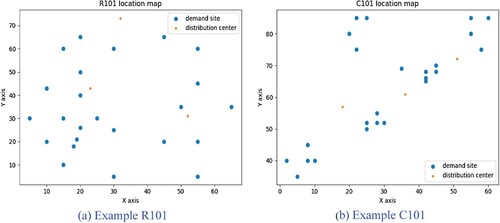
Table 3. R101 example demand point information table.
Table 4. R101 example distribution centre information table.
Table 5. R101 example distribution vehicle information table.
Table 6. C101 example demand point information table.
Table 7. C101 example distribution centre information table.
Table 8. C101 example distribution vehicle information table.
5.2. Numerical simulation and results
5.2.1. Analysis of optimal results of emergency materials distribution
It can be seen from the above that the first-stage model of the emergency scheduling problem is solved in this section, namely the fair distribution model of emergency materials. Due to the great impact of the epidemic and the shortage of the originally stored medical materials, the medical materials are in short supply for a short period, so they cannot meet all the demands of all demand points. Combined with the number of patients at the demand points and the urgency of the demand for emergency materials published by the local government, the priority calculation formula of the demand points in Formula (7) was used to determine the priority of the demand points. When the demand for emergency supplies exceeds the supply in the early stage of an epidemic, it is assumed that demand urgency at the point of need outweighs time tolerance at said point, i.e. a > b, and satisfies the following conditions: , 0
and
. Let the parameters a = 0.8 and b = 0.2 be utilised to calculate the priority of demand points, maximise life-saving efforts, and enhance rescue efficiency. The genetic algorithm's iteration number is set at 1000, with a population size of 100 and a penalty factor
= 10 for vehicles that exceed their tolerance time.
In this paper, Pycharm2020.1.1 is used for programming solutions. First, R101 and C101 example data are inputted, and then the fair distribution model of the first stage is solved. Second, we run 10 times to take the average value as the objective function ; the iterative process of the optimisation results is shown in Figure . Finally, we obtain the optimal objective function value
= 0.083, for example, R101 and
= 0.054, for example, C101.
Figure 3. Iteration diagram of fair index optimisation: (a) R101 iterative graph of fair index optimisation: (b) C101 iterative graph of fair index optimisation.
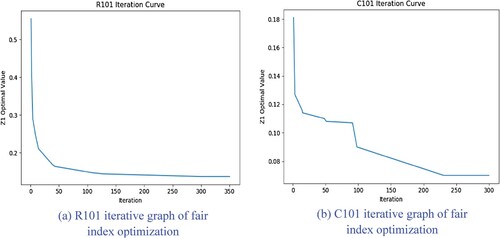
5.2.2. Analysis of emergency vehicle routing optimisation results
In the first phase of the material assigned based on solving the second stage of the vehicle routing optimisation problem, optimising the parameters of the ant colony algorithm largely determines the algorithm's convergence. So, first of all, through the control variable method, we find the optimal parameter of the ant colony algorithm by running 10 times the optimal result; the run results are shown in Figure .
Figure 4. Ant colony parameter tuning: (a) ACS algorithm and parameter: (b) MMAS algorithm and parameter: (c) ACS algorithm parameter selection: (d) MMAS algorithm parameter selection: (e) Ant Quantity.
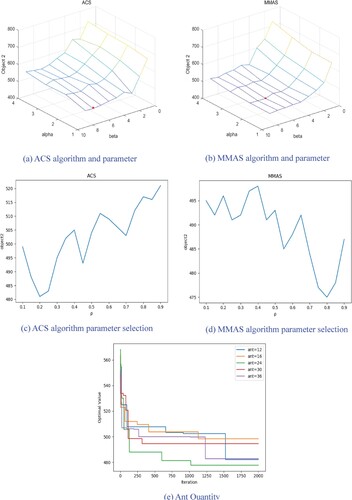
Since both ACS and MMAS adopt adaptive parameters in the process of dual population communication, the parameters greatly influence the experimental results. The number of ants will affect the trend of the average pheromone tends to average. The information heuristic factor α and the expected elicitation factor β control the exploration and convergence of the population, so it is necessary to adjust the parameters before the experiment. Under the minimum Gini coefficient constraint, each group of parameters is substituted into the algorithm and run 10 times to take the average value. The experimental results are shown in Figure . For ACS, information heuristic factor α = 1, expected heuristic factor β = 8, pheromone volatilisation factor ρ = 0.2; for MMAS, information heuristic factor α = 2, expected heuristic factor β = 7, pheromone volatilisation factor ρ = 0.8, and Ant = 24.
The material distribution scheme obtained in the previous section is substituted into the path optimisation model for the solution. The specific vehicle distribution scheme is shown in Tables and , and the obtained optimal route diagram is shown in Figure , with each colour line representing the distribution route of each vehicle.
Figure 5. Roadmap of vehicle distribution: (a) R101 Vehicle distribution roadmap: (b) C101 Vehicle distribution roadmap.
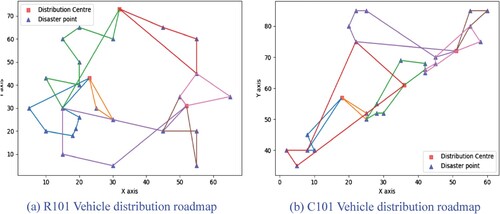
Table 9. R101 is an example of a vehicle distribution route.
Table 10. C101 is an example of a vehicle distribution route.
To verify the impact of the priority index on fairness, a control group is set up in this subsection, the priority of the demand point is not considered, and the material quantity is allocated only according to the proportion of demand point to demand point. The Pareto solution set of minimum scheduling time is used for comparison, and the penalty cost is calculated according to the penalty factor set above. The comparison results are shown in Table . The difference in scheduling time between the distribution scheme without considering the priority and the distribution scheme considering the priority is small, but the difference in scheduling penalty cost is large. It can be found that the distribution scheme considering the priority of the demand point is better in fairness, which ensures the balance between fairness and efficiency of emergency rescue to a certain extent.
Table 11. Comparison of the results of two allocation schemes.
5.2.3. Algorithm performance analysis
Algorithm convergence
Table 12. R101 example algorithm comparison results.
Table 13. C101 example algorithm comparison results.
Then, the parameters of the ant colony algorithm optimised in the previous subsection were put into the model and ran 10 times to obtain the optimal solution. The convergence of the ACS-MMAS algorithm, ACS algorithm, and MMAS algorithm was compared, and ε was set equal to its upper bound value for constraint, and the solution with minimum scheduling time was compared and analysed. It can be seen from Figure that the ACS-MMAS algorithm can effectively jump out of the local optimal solution, avoid the premature of the algorithm, and have better convergence for the operations optimisation problem.
Pareto frontier
Oervolume index
This subsection further comprehensively verifies the convergence, diversity, and universality of the proposed algorithm from the hypervolume index. The hypervolume values of the ACS-MMAS algorithm, ACS algorithm, and MMAS algorithm are respectively calculated by selecting appropriate reference points in the dominant region of the Pareto front. Super volume value is surrounded by several hypercube areas to make the problem of two-dimensional target hypervolume value calculation easier, assuming a non-dominated solution set , where
represent three groups of Pareto solutions, and the super volume value is the sum of several hypercube volumes. In a two-dimensional space solution set
, super value is equal to the volume of the area of the shaded part, as shown in Figure ’s non-dominated solution set of the area. The greater the quality of the solution set, the better it is. The average value of the optimal solution is taken by running the different algorithms 10 times, and the value range of the two objective functions is scaled down to [0,1] to calculate the hypervolume value. Table shows that the hypervolume value of the ACS-MMAS algorithm proposed in this paper is larger than that of other heuristic algorithms, indicating that the solution set obtained by the algorithm is closer to the real Pareto front. It is a better non-dominant solution set.
Figure 6. Comparison of algorithm convergence: (a) Comparison of algorithm convergence in R101 example: (b) Comparison of algorithm convergence in C101 example.

Figure 7. Pareto frontier comparison of algorithms: (a) R101 example Pareto frontier: (b) C01 example Pareto frontier.
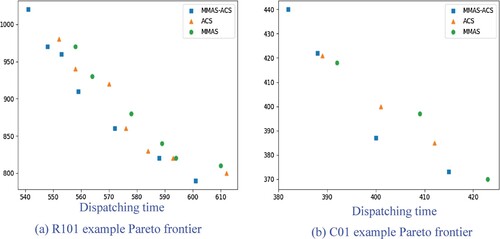
Figure 8. Shadow area is the HV value of the solution set S′.
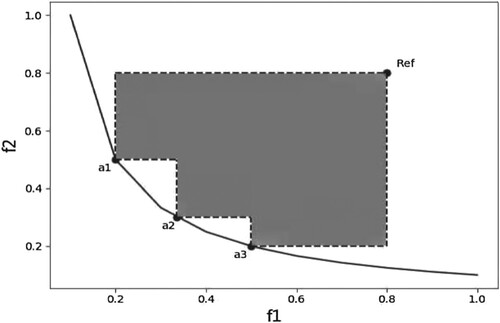
Table 14. Algorithm HV value comparison.
6. Discussion
This paper proposes a novel algorithm for optimising medical supplies scheduling, ACS-MMAS, based on a reinforcement learning mechanism. The experimental results demonstrate that the convergence speed and search effectiveness of ACS-MMAS are superior to those of both ACS and MMAS algorithms, and they can escape from local optima during the search process. As the number of iterations increases, the HV index of ACS-MMAS exhibits a significant advantage over that of ACS, MMAS, and NSGA-II. The proposed ACS-MMAS algorithm outperforms other heuristics in terms of performance. Integrating AI algorithms and traditional heuristic algorithms can enhance algorithmic efficiency and improve rationality and timeliness in medical supply allocation.
Specifically, We propose a bi-objective optimisation model that prioritises fairness and timeliness in emergency medical services (EMS) during the pre-disaster period of major public health events. Our approach utilises ACS-MMAS, a reinforcement learning mechanism that balances EMS distribution and dispatching efficiency. The ε-constraint method is introduced in this study to solve the Pareto solution of a conflicting bi-objective function, and an optimal vehicle dispatching route is obtained through simulation experiments. The research on the emergency logistics scheduling problem of public health emergencies is insufficient. Many studies discuss the theoretical management methods of emergency logistics and explore emergency response at a theoretical level, but there is a lack of specific material distribution schemes and path planning schemes that are combined with practical applications. Most scholars tend to examine the issues of emergency supplies’ distribution and transportation in isolation. However, considering the practical scenario, when scheduling emergency supplies, distribution and transportation problems are closely intertwined and should be studied together to ensure a comprehensive emergency plan.
From an AI perspective, advanced technologies are utilised to optimise EMSS. The theoretical significance of our research results lies in providing a superior research methodology for addressing the problem of EMSS before major public health events. In terms of practical significance, our study considers both timeliness and fairness, effectively resolving issues related to unequal distribution due to varying demand at each disaster point and minimising losses. For the assessment of equity in EMS, most existing studies fail to fully consider the influencing factors and rely solely on a single index or factor to evaluate distribution equity. Additionally, current literature only employs convergence or Pareto front as verification indices when assessing model or algorithm effectiveness and practicality, lacking comprehensive comparative research. The paper incorporates the hypervolume index to comprehensively evaluate algorithmic performance, thereby offering sound theoretical support for actual disaster relief efforts through optimised scheduling of MES.
7. Conclusion
7.1. Theoretical contribution
The ACS-MMAS model of EMSS based on AI is constructed
A bi-objective optimisation model is formulated to balance the fairness and timeliness of EMS
7.2. Practical contribution
The distribution of medical supplies during public health events and the application scope of the accurate model proposed in this research have significant implications for practitioners in the field. The following will be analysed from three dimensions of human, organisation, and technology. For decision-makers, the impact of priority on scheduling schemes is analysed by comparing the models, and suggestions are provided for decision-makers to balance the fairness and efficiency of scheduling schemes. For the affected people, the distribution of medical supplies according to this model can reduce the mortality rate of the population, meet the basic medical supplies and treatment, and enable them to lead a happier and better new life as soon as possible.
For management, it can reasonably manage medical materials in major public health events, effectively control the impact of events, and contribute to the prevention and emergency decision-making of public health events. In response to a public health outbreak, emergency medical rescue prevention and control measures have exposed the disordered, chaotic, and inefficient logistics of medical supplies. Meanwhile, the difference between multiple demand points and supply points of medical supplies is prominent, significantly reducing the effect of medical treatment services and the prevention and control efficiency of major public health emergencies. Therefore, suitable locations and selection of material warehouses for suppliers of medical supplies can meet the needs of medical supplies in disaster areas with different priorities in the event of public health events.
Advanced technologies can improve the ability to deal with major public health emergencies. New technologies such as 5G, blockchain, the Internet of things, AI, and big data should be fully utilised to monitor and warn about public health events more accurately and effectively, strengthen the monitoring mechanism for unexplained diseases and abnormal public health events, and improve the sensitivity and accuracy of assessment and monitoring. Moreover, a multi-point trigger mechanism is established for intelligent early warning.
7.3. Limitations and future research directions
To sum up, it is necessary to optimise the EMSS scheme in the early stage of public health events, which can reduce the loss and casualties and appease the emotion of disaster victims. However, there are still several limitations in this paper. First, the impact of public health events on traffic roads is not considered. Second, we have not taken into consideration the inventory problem of a distribution centre, vehicle transportation cost, and service time of picking up and delivering goods. These factors also affect the medical supplies scheduling problem. Future models also need to take into account dynamic variables. In the process of transportation of medical supplies, the path optimisation problem of this paper does not consider the changes in road capacity, and the transportation modes and constraints of different kinds of EMS are different. Such dynamic factors will also impact the transportation process, and integrating more dynamic factors into the scheduling model is the main goal of subsequent research.
Disclosure statement
No potential conflict of interest was reported by the author(s).
Data availability statement
Data available on request from the authors.
Additional information
Funding
Notes on contributors

Huosong Xia
Dr. Huosong Xia is a professor in the School of Management at Wuhan Textile University. He graduated from Huazhong University of Science and Technology of China and was a visiting scholar at Eller College of Management of the University of Arizona, USA, from 2006 to 2007. His main research interests are knowledge management, data mining, e-commerce and logistics information systems, and Fintech. He has published over 100 papers in refereed journals, book chapters, and conferences, such as Journal of Knowledge Management, Decision Support Systems, International Journal of Knowledge Management, Knowledge Management Research & Practice, Electronic Commerce Research, Electronic Markets, Journal of Computer Information Systems, Enterprise Information Systems, Production Planning & Control, Annals of Operations Research, Socio-Economic Planning Sciences, Expert Systems With Applications, International Journal of Ad Hoc and Ubiquitous Computing, International Journal of Innovation Science, Information Discovery and Delivery, International Journal of Management, Journal of Systems Science and Information, Technology Analysis & Strategic Management, Journal of Grey System, Financial Innovation, etc. He has obtained research funding for five projects, including those from National Social Science Foundation of China and National Science Foundation of China.

Zelin Sun
Zelin Sun is a graduate student in the School of Management at Wuhan Textile University. He holds a bachelor’s degree in mathematics from Wuhan Textile University. His research interests include data mining and e-commerce.

Yuan Wang
Yuan Wang is a graduate student in the School of Management at Wuhan Textile University. She holds a bachelor’s degree in Computer Science and Technology. Her main research interests are Fintech, knowledge management, data mining, and e-commerce. She has published multiple papers in journals, such as International Journal of Production Research, Technological Forecasting & Social Change, Expert Systems with Applications, etc.

Justin Zuopeng Zhang
Dr. Justin Zhang is a faculty member in the Department of Management at the University of North Florida. He received his Ph.D. in Business Administration with a concentration on Management Science and Information Systems from Pennsylvania State University, University Park. His research interests include economics of information systems, knowledge management, electronic business, business process management, information security, and social networking. He is the editor-in-chief of the Journal of Global Information Management, an ABET programme evaluator, and an IEEE senior member.

Muhammad Mustafa Kamal
Muhammad Mustafa Kamal is an associate professor in Supply Chain Management, Curriculum Lead (Subject Head) in Decision Making, Business Analytics and Risk Management and Director of the Structured PhD (Online) Programme at the School of Strategy and Leadership, Coventry University. Prior to joining Coventry University, he was a Senior Lecturer in Operations and Supply Chain Management, Director of UG Programmes and Director of Alumni at the Brunel Business School, Brunel University London. He earned his Doctorate in Information Systems from Brunel University London. His areas of specialism are Digitisation/Digitalisation of Supply Chains and Operations Management. Other research interests include Circular Economy, Industry 4.0, Disruptive Technologies, Information Systems and Technology Management, Social Media, Big Data and Business Analytics, and Supply Chain Integration. Currently, he is the Deputy Editor for the Journal of Enterprise Information Management, Senior Editor for Information Technology and People and Information Systems Management and on the Editorial Board for Government Information Quarterly and International Journal of Information Management. He has published over 90 papers in refereed academic journals, conference proceedings, book chapters, and magazine article. His research work has appeared in several leading ABS ranked journals, such as IJPR, JBR, I&M, PPC, ESA, GIQ, SCMIJ, TFSC, CIE, ISF, ITP, CHB, IMM, and JORS, JEIM, IJIM, and ISM. He has also presented his research papers at globally esteemed conferences such as BAM, ECIS, AMCIS, and HICSS. He has also chaired conferences and tracks at leading conferences including AMCIS, ECIS and HICSS. He has worked on several internal and external research grant (including EU Framework 7, Horizon 2020, Qatar National Research Foundation and Erasmus+).

Sajjad M. Jasimuddin
Sajjad M. Jasimuddin is a professor (professor senior) at the Kedge Business School, France. Previously, he was faculty at Aberystwyth University (UK), Southampton University (UK), King Abdulaziz University (Saudi Arabia), and University of Dhaka (Bangladesh). He received MCom from Dhaka University, MPhil from Judge Business School at Cambridge University (Trinity College), and PhD from Southampton University. and is visiting Professor at Renmin University of China, and University of Dubai. He is Associate Editor of the Journal of Global Information Management. Sajjad has authored a textbook, 15 chapters, and 115 articles – appeared in European Journal of Operational Research, International Business Review, Information Systems Journal, Technological Forecasting & Social Change, International Journal of Production Research, Annals of Operational Research, Production Planning & Control, Electronic Markets, Journal of Operational Research Society, European Management Journal, Journal of Innovation & Knowledge, Annals of Regional Science, Thunderbird International Business Review, Information Systems Management, Supply Chain Forum: An International Journal, Management Decision, Journal of Global Information Management, Journal of Business & Industrial Marketing, International Journal of Organizational Analysis, International Journal of Information Management, Journal of General Management, Industrial Management & Data Systems, Journal of Information & Knowledge Management, Journal of Knowledge Management, Knowledge & Process Management, Knowledge Management Research & Practice.

Nazrul Islam
Nazrul Islam is Chair Professor of Business & Director of Research Degrees, and Associate Director for Centre of FinTech at Royal Docks School of Business and Law, University of East London, UK. He holds a PhD in innovation management. His research interest focuses on interdisciplinary fields: the management of technology; technological transformation; the emergence and growth of disruptive and digital technology-based innovation; and SMEs business sustainability. His research was published in the leading international journals, and he has complemented his peer reviewed journal efforts with three books. Prof Islam’s research received awards including the ‘Brad Hosler Award for Outstanding Paper’ from USA; and the ‘Pratt & Whitney Canada Best Paper Award’ from Canada. Prof Islam serves on the board of directors for Business and Applied Sciences Academy of North America. He is an Associate Editor for Technological Forecasting & Social Change, Department Editor for IEEE Transactions on Engineering Management, and Editor-in-Chief of International Journal of Technology Intelligence and Planning. He has acted as managing guest editor for several special issues for Technovation, TFSC, IEEE TEM among others.
References
- Adulyasak, Y., J. F. Cordeau, and R. Jans. 2014. “Formulations and Branch-and-cut Algorithms for Multi-Vehicle Production and Inventory Routing Problems.” INFORMS Journal on Computing 26 (1): 103–120. https://doi.org/10.1287/ijoc.2013.0550
- Alem, D., A. M. Caunhye, and A. Moreno. 2022. “Revisiting Gini for Equitable Humanitarian Logistics.” Socio-Economic Planning Sciences 82: 101312. 11.top/10.1016j.seps.2022.101312.
- Alshurideh, M. T., B. Al Kurdi, H. M. Alzoubi, T. M. Ghazal, R. A. Said, A. Q. Al Hamad, A. Hamadneh, N. Sahawneh, and A. H. Al-kassem. 2022. “Fuzzy Assisted Human Resource Management for Supply Chain Management Issues.” Annals of Operations Research 39: 1–19. https://doi.org/10.1007/s10479-021-04472-8.
- Boutilier, J. J., and T. C. Chan. 2020. “Ambulance Emergency Response Optimization in Developing Countries.” Operations Research 68 (5): 1315–1334. https://doi.org/10.1287/opre.2019.1969
- Cerna, S., H. H. Arcolezi, C. Guyeux, G. Royer-Fey, and C. Chevallier. 2021. “Machine Learning-Based Forecasting of Firemen Ambulances’ Turnaround Time in Hospitals, Considering the COVID-19 Impact.” Applied Soft Computing 109: 107561. 11.top/10.1016j.asoc.2021.107561.
- Chang, K. H., T. L. Chen, F. H. Yang, and T. Y. Chang. 2023a. “Simulation Optimization for Stochastic Casualty Collection Point Location and Resource Allocation Problem in a Mass Casualty Incident.” European Journal of Operational Research 309 (3): 1237–1262. https://doi.org/10.1016/j.ejor.2023.01.065
- Chang, V., Q. A. Xu, K. Hall, Y. A. Wang, and M. M. Kamal. 2023b. “Digitalization in Omnichannel Healthcare Supply Chain Businesses: The Role of Smart Wearable Devices.” Journal of Business Research 156: 113369. https://doi.org/10.1016/j.jbusres.2022.113369
- Chen, W., H. Guo, and K. L. Tsui. 2020. “A new Medical Staff Allocation via Simulation Optimisation for an Emergency Department in Hong Kong.” International Journal of Production Research 58 (19): 6004–6023. https://doi.org/10.1080/00207543.2019.1665201
- Chen, J., F. Ling, Y. Zhang, T. You, Y. Liu, and X. Du. 2022. “Coverage Path Planning of Heterogeneous Unmanned Aerial Vehicles Based on ant Colony System.” Swarm and Evolutionary Computation 69: 101005. 11.top/10.1016j.swevo.2021.101005.
- den Berg, P. V., and J. T. van Essen. 2019. “Scheduling non-Urgent Patient Transportation While Maximizing Emergency Coverage.” Transportation Science 53 (2): 492–509. https://doi.org/10.1287/trsc.2018.0823
- Deng, J., X. Chen, W. Wei, and J. Liang. 2023. “Resource Coordination Scheduling Optimisation of Logistics Information Sharing Platform Considering Decision Response and Competition.” Computers & Industrial Engineering 176: 108892. 11.top/10.1016j.cie.2022.108892.
- Deng, W., X. Zhang, Y. Zhou, Y. Liu, X. Zhou, H. Chen, and H. Zhao. 2022. “An Enhanced Fast non-Dominated Solution Sorting Genetic Algorithm for Multi-Objective Problems.” Information Sciences 585: 441–453. https://doi.org/10.1016/j.ins.2021.11.052
- Ding, Y., E. Park, M. Nagarajan, and E. Grafstein. 2019. “Patient Prioritization in Emergency Department Triage Systems: An Empirical Study of the Canadian Triage and Acuity Scale (CTAS).” Manufacturing & Service Operations Management 21 (4): 723–741. https://doi.org/10.1287/msom.2018.0719
- Dolgui, A., and D. Ivanov. 2022. “5G in Digital Supply Chain and Operations Management: Fostering Flexibility, end-to-end Connectivity and Real-Time Visibility Through Internet-of-Everything.” International Journal of Production Research 60 (2): 442–451. https://doi.org/10.1080/00207543.2021.2002969
- Dorigo, M., and L. M. Gambardella. 1997. “Ant Colony System: A Cooperative Learning Approach to the Traveling Salesman Problem.” IEEE Transactions on Evolutionary Computation 1 (1): 53–66.
- Ekici, A., P. Keskinocak, and J. L. Swann. 2014. “Modeling Influenza Pandemic and Planning Food Distribution.” Manufacturing & Service Operations Management 16 (1): 11–27. https://doi.org/10.1287/msom.2013.0460
- Fernández Gil, A., E. Lalla-Ruiz, M. Gómez Sánchez, and C. Castro. 2023. “The Cumulative Vehicle Routing Problem with Time Windows: Models and Algorithm.” Annals of Operations Research 39: 1–29. https://doi.org/10.1007/s10479-022-05102-7.
- Fukasawa, R., Q. He, F. Santos, and Y. Song. 2018. “A Joint Vehicle Routing and Speed Optimization Problem.” INFORMS Journal on Computing 30 (4): 694–709. https://doi.org/10.1287/ijoc.2018.0810
- Gao, X., X. Jin, P. Zheng, and C. Cui. 2021. “Multi-modal Transportation Planning for Multi-Commodity Rebalancing Under Uncertainty in Humanitarian Logistics.” Advanced Engineering Informatics 47: 101223. 11.top/10.1016j.aei.2020.101223.
- Gini, C.. 1912. “Variabilità e mutabilità: contributo allo studio delle distribuzioni e delle relazioni statistiche.” Studi Economico-Giuridici dell' Universita di Cagliari 3: 1–158.
- Gini, C. 1921. “Measurement of Inequality of Incomes.” The Economic Journal 31 (121): 124–125. https://doi.org/10.2307/2223319
- Gökalp, E., M. S. Cakir, and I. Kougkoulos. 2022. “Capacity Management of Migrant Accommodation Centers Using Approximate Dynamic Programming.” Journal of the Operational Research Society 73 (6): 1198–1210. https://doi.org/10.1080/01605682.2021.1907242
- Hasan, R., M. M. Kamal, A. Daowd, T. Eldabi, I. Koliousis, and T. Papadopoulos. 2022. “Critical Analysis of the Impact of big Data Analytics on Supply Chain Operations.” Production Planning & Control 33: 1–25. https://doi.org/10.1080/09537287.2022.2047237.
- He, W., J. Z. Zhang, H. Wu, W. Li, and S. Shetty. 2022. “A Unified Health Information System Framework for Connecting Data, People.” Devices, and Systems. Journal of Global Information Management (JGIM) 30 (11): 1–19. https://doi.org/10.4018/JGIM.305239.
- Helo, P., and Y. Hao. 2022. “Artificial Intelligence in Operations Management and Supply Chain Management: An Exploratory Case Study.” Production Planning & Control 33 (16): 1573–1590. https://doi.org/10.1080/09537287.2021.1882690
- Hu, H., X. Jia, Q. He, S. Fu, and K. Liu. 2020. “Deep Reinforcement Learning Based AGVs Real-Time Scheduling with Mixed Rule for Flexible Shop Floor in Industry 4.0.” Computers & Industrial Engineering 149: 106749. https://doi.org/10.1016/j.cie.2020.106749.
- Jenkins, P. R., M. J. Robbins, and B. J. Lunday. 2021. “Approximate Dynamic Programming for Military Medical Evacuation Dispatching Policies.” INFORMS Journal on Computing 33 (1): 2–26. https://doi.org/10.1287/ijoc.2019.0930
- Karimi, F., M. B. Dowlatshahi, and A. Hashemi. 2023. “SemiACO: A Semi-Supervised Feature Selection Based on ant Colony Optimization.” Expert Systems with Applications 214: 119130. 10.1016j.eswa.2022.119130.
- Khishe, M., N. Orouji, and M. R. Mosavi. 2023. “Multi-objective Chimp Optimizer: An Innovative Algorithm for Multi-Objective Problems.” Expert Systems with Applications 211: 118734. 11.top/10.1016j.eswa.2022.118734.
- Kumar, A., and R. Dimitrakopoulos. 2021. “Production Scheduling in Industrial Mining Complexes with Incoming new Information Using Tree Search and Deep Reinforcement Learning.” Applied Soft Computing 110: 107644. https://doi.org/10.1016/j.resourpol.2022.102727.
- Kundu, T., J. B. Sheu, and H. T. Kuo. 2022. “Emergency Logistics Management—Review and Propositions for Future Research.” Transportation Research Part E: Logistics and Transportation Review 164: 102789. https://doi.org/10.1016/j.tre.2022.102789.
- Kuo, Y. H., J. M. Leung, and Y. Yan. 2023. “Public Transport for Smart Cities: Recent Innovations and Future Challenges.” European Journal of Operational Research 306 (3): 1001–1026. https://doi.org/10.1016/j.ejor.2022.06.057
- Li, M., D. Yin, H. Qiu, and B. Bai. 2021. “A Systematic Review of AI Technology-Based Service Encounters: Implications for Hospitality and Tourism Operations.” International Journal of Hospitality Management 95: 102930. https://doi.org/10.1016/j.ijhm.2021.102930.
- Li, S., X. You, and S. Liu. 2021. “Multiple ant Colony Optimization Using Both Novel LSTM Network and Adaptive Tanimoto Communication Strategy.” Applied Intelligence 51 (8): 5644–5664. https://doi.org/10.1007/s10489-020-02099-z
- Lin, C. C., K. Y. Chen, and L. T. Hsieh. 2023. “Real-Time Charging Scheduling of Automated Guided Vehicles in Cyber-Physical Smart Factories Using Feature-Based Reinforcement Learning.” IEEE Transactions on Intelligent Transportation Systems 24 (4): 4016–4026. https://doi.org/10.1109/TITS.2023.3234010.
- Liu, S., X. He, F. T. Chan, and Z. Wang. 2022. “An Extended Multi-Criteria Group Decision-Making Method with Psychological Factors and Bidirectional Influence Relation for Emergency Medical Supplier Selection.” Expert Systems with Applications 202: 117414. https://doi.org/10.1016/j.eswa.2022.117414.
- Liu, H., S. Wei, W. Ke, K. K. Wei, and Z. Hua. 2016. “The Configuration Between Supply Chain Integration and Information Technology Competency: A Resource Orchestration Perspective.” Journal of Operations Management 44 (1): 13–29. https://doi.org/10.1016/j.jom.2016.03.009
- Lopes, T. C., A. S. Michels, N. Brauner, and L. Magatão. 2022. “Balancing-sequencing Paced Assembly Lines: A Multi-Objective Mixed-Integer Linear Case Study.” International Journal of Production Research 61 (17): 5901–5917. https://doi.org/10.1080/00207543.2022.2118888.
- Lu, C. C., K. C. Ying, and H. J. Chen. 2016. “Real-time Relief Distribution in the Aftermath of Disasters–A Rolling Horizon Approach.” Transportation Research Part E: Logistics and Transportation Review 93: 1–20. https://doi.org/10.1016/j.tre.2016.05.002
- Luo, L., X. Wan, and Q. Wang. 2022. “A Multi-Period Location–Allocation Model for Integrated Management of Emergency Medical Supplies and Infected Patients During Epidemics.” Computers & Industrial Engineering 173: 108640. https://doi.org/10.1016/j.cie.2022.108640.
- Mills, A. F., N. T. Argon, and S. Ziya. 2018. “Dynamic Distribution of Patients to Medical Facilities in the Aftermath of a Disaster.” Operations Research 66 (3): 716–732. https://doi.org/10.1287/opre.2017.1695
- Nasrollahzadeh, A. A., A. Khademi, and M. E. Mayorga. 2018. “Real-time Ambulance Dispatching and Relocation.” Manufacturing & Service Operations Management 20 (3): 467–480. https://doi.org/10.1287/msom.2017.0649
- Noriega, R., and Y. Pourrahimian. 2022. “A Systematic Review of Artificial Intelligence and Data-Driven Approaches in Strategic Open-pit Mine Planning.” Resources Policy 77: 102727. https://doi.org/10.1016/j.asoc.2021.107644.
- Petchrompo, S., D. W. Coit, A. Brintrup, A. Wannakrairot, and A. K. Parlikad. 2022. “A Review of Pareto Pruning Methods for Multi-Objective Optimization.” Computers & Industrial Engineering 108022. https://doi.org/10.1016/j.cie.2022.108022.
- Petrović, M., A. Jokić, Z. Miljković, and Z. Kulesza. 2022. “Multi-objective Scheduling of a Single Mobile Robot Based on the Grey Wolf Optimization Algorithm.” Applied Soft Computing 131: 109784. https://doi.org/10.1016/j.asoc.2022.109784.
- Raimundo, M. M., P. A. Ferreira, and F. J. Von Zuben. 2020. “An Extension of the Non-Inferior set Estimation Algorithm for Many Objectives.” European Journal of Operational Research 284 (1): 53–66. https://doi.org/10.1016/j.ejor.2019.11.017
- Rautenstrauss, M., L. Martin, and S. Minner. 2023. “Ambulance Dispatching During a Pandemic: Tradeoffs of Categorizing Patients and Allocating Ambulances.” European Journal of Operational Research 304 (1): 239–254. https://doi.org/10.1016/j.ejor.2021.11.051
- Shirazi, H., R. Kia, and P. Ghasemi. 2021. “A Stochastic bi-Objective Simulation–Optimization Model for Plasma Supply Chain in Case of COVID-19 Outbreak.” Applied Soft Computing 112: 107725. https://doi.org/10.1016/j.asoc.2021.107725.
- Shrivastav, M. 2022. “Barriers Related to AI Implementation in Supply Chain Management.” Journal of Global Information Management (JGIM) 30 (8): 1–19. https://doi.org/10.4018/JGIM.296725.
- Sodhi, M. S., C. S. Tang, and E. T. Willenson. 2023. “Research Opportunities in Preparing Supply Chains of Essential Goods for Future Pandemics.” International Journal of Production Research 61 (8): 2416–2431. https://doi.org/10.1080/00207543.2021.1884310
- Stutzle, T., and H. Hoos. 1997, April. “MAX-MIN ant System and Local Search for the Traveling Salesman Problem.” In Proc IEEE International Conference on Evolutionary Computation, 309–314. Indianapolis, IN, USA.
- Tian, Y., L. Si, X. Zhang, R. Cheng, C. He, K. C. Tan, and Y. Jin. 2021. “Evolutionary Large-Scale Multi-Objective Optimization: A Survey.” ACM Computing Surveys 54 (8): 1–34.
- Tomczyk, M. K., and M. Kadziński. 2022. “Interactive Co-evolutionary Multiple Objective Optimization Algorithms for Finding Consensus Solutions for a Group of Decision Makers.” Information Sciences 616: 157–181. https://doi.org/10.1016/j.ins.2022.10.064
- Toorajipour, R., V. Sohrabpour, A. Nazarpour, P. Oghazi, and M. Fischl. 2021. “Artificial Intelligence in Supply Chain Management: A Systematic Literature Review.” Journal of Business Research 122: 502–517. https://doi.org/10.1016/j.jbusres.2020.09.009
- van Lieshout, R. N., P. C. Bouman, and D. Huisman. 2020. “Determining and Evaluating Alternative Line Plans in Out-of-Control Situations.” Transportation Science 54 (3): 740–761. https://doi.org/10.1287/trsc.2019.0945
- Vishwakarma, L. P., R. K. Singh, R. Mishra, and A. Kumari. 2023. “Application of Artificial Intelligence for Resilient and Sustainable Healthcare System: Systematic Literature Review and Future Research Directions.” International Journal of Production Research 63: 1–23. https://doi.org/10.1080/00207543.2023.2188101.
- Wan, M., C. Ye, and D. Peng. 2023. “Multi-period Dynamic Multi-Objective Emergency Material Distribution Model Under Uncertain Demand.” Engineering Applications of Artificial Intelligence 117: 105530. 11.top/10.1016j.engappai.2022.105530.
- Wang, Z., S. Cui, and L. Fang. 2023. “Distance-Based Service Priority: An Innovative Mechanism to Increase System Throughput and Social Welfare.” Manufacturing & Service Operations Management 25 (1): 353–369. https://doi.org/10.1287/msom.2022.1157
- Wang, H., S. C. Fang, M. Huang, Q. Zhang, and Z. Deng. 2022. “A Joint Model of Location, Inventory and Third-Party Logistics Provider in Supply Chain Network Design.” Computers & Industrial Engineering 174: 108809. https://doi.org/10.1016/j.cie.2022.108809.
- Wang, D., K. Yang, and L. Yang. 2023. “Risk-averse Two-Stage Distributionally Robust Optimisation for Logistics Planning in Disaster Relief Management.” International Journal of Production Research 61 (2): 668–691. https://doi.org/10.1080/00207543.2021.2013559
- Wang, L., X. Zhao, and P. Wu. 2023. “Large-scale Emergency Medical Services Scheduling During the Outbreak of Epidemics.” Annals of Operations Research 39: 1–25. https://doi.org/10.1007/s10479-023-05218-4.
- Wilson, D. T., G. I. Hawe, G. Coates, and R. S. Crouch. 2016. “Online Optimization of Casualty Processing in Major Incident Response: An Experimental Analysis.” European Journal of Operational Research 252 (1): 334–348. https://doi.org/10.1016/j.ejor.2016.01.021
- Yang, Y., L. Dong, H. Rong, and J. Wu. 2021. “Optimization on Medical Material Distribution Management System Based on Artificial Intelligence Robot.” Journal of Healthcare Engineering 2021: 1–12. https://doi.org/10.1155/2021/5511299.
- Yang, K., M. Emmerich, A. Deutz, and T. Bäck. 2019. “Multi-Objective Bayesian Global Optimization Using Expected Hypervolume Improvement Gradient.” Swarm and Evolutionary Computation 44: 945–956. https://doi.org/10.1016/j.swevo.2018.10.007
- Yi, J., H. Zhang, J. Mao, Y. Chen, H. Zhong, and Y. Wang. 2022. “Review on the COVID-19 Pandemic Prevention and Control System Based on AI.” Engineering Applications of Artificial Intelligence 105184. 11.top/10.1016j.engappai.2022.105184.
- Ying, K. C., P. Pourhejazy, C. Y. Cheng, and R. S. Syu. 2023. “Supply Chain-Oriented Permutation Flowshop Scheduling Considering Flexible Assembly and Setup Times.” International Journal of Production Research 61 (1): 258–281. https://doi.org/10.1080/00207543.2020.1842938
- Yüksel, N., H. R. Börklü, H. K. Sezer, and O. E. Canyurt. 2023. “Review of Artificial Intelligence Applications in Engineering Design Perspective.” Engineering Applications of Artificial Intelligence 118: 105697. https://doi.org/10.1016/j.engappai.2022.105697.
- Zhan, S. L., S. Liu, J. Ignatius, D. Chen, and F. T. Chan. 2021. “Disaster Relief Logistics Under Demand-Supply Incongruence Environment: A Sequential Approach.” Applied Mathematical Modelling 89: 592–609. https://doi.org/10.1016/j.apm.2020.07.002
- Zhang, C., J. Zhou, J. Wang, J. Fan, and Y. Shi. 2023. “Fairness-Aware Competitive Bidding Influence Maximization in Social Networks.” IEEE Transactions on Computational Social Systems 10: 1–13. https://doi.org/10.1109/TCSS.2023.3285605.
- Zhou, Y., W. Li, X. Wang, Y. Qiu, and W. Shen. 2022. “Adaptive Gradient Descent Enabled Ant Colony Optimization for Routing Problems.” Swarm and Evolutionary Computation 70: 101046. 11.top/10.1016j.swevo.2022.101046.
- Zhou, P., Z. Xu, X. Zhu, J. Zhao, C. Song, and Z. Shao. 2023. “Safe Reinforcement Learning Method Integrating Process Knowledge for Real-Time Scheduling of Gas Supply Network.” Information Sciences 633: 280–304. 11.top/10.1016j.ins.2023.02.084.

